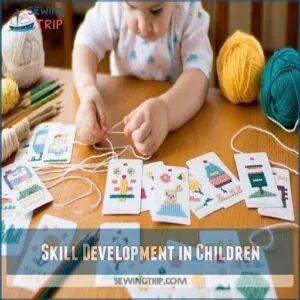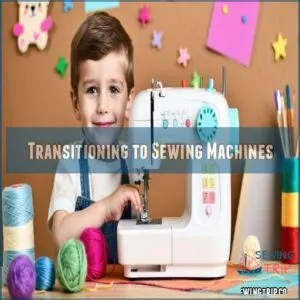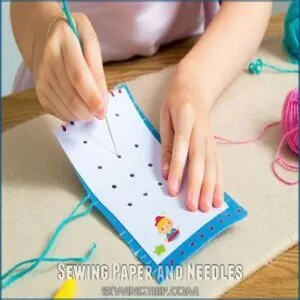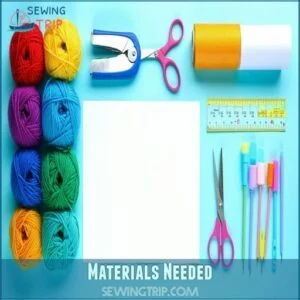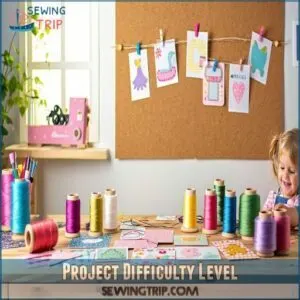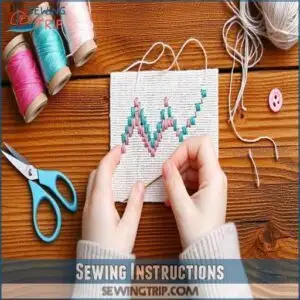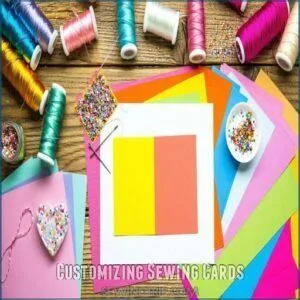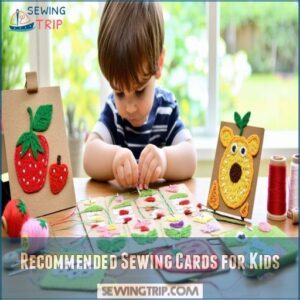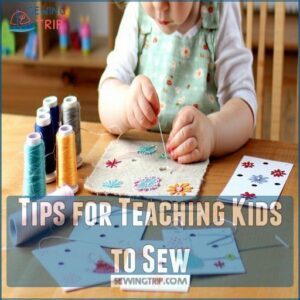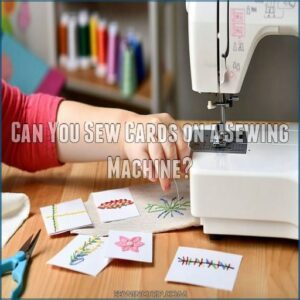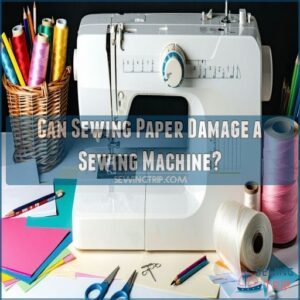This site is supported by our readers. We may earn a commission, at no cost to you, if you purchase through links.
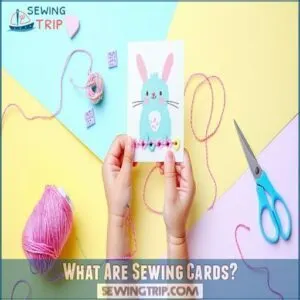
These clever tools help develop fine motor skills and hand-eye coordination while sparking creativity. You can choose from various themed designs or create your own custom cards.
With just some cardstock, a hole punch, and yarn, you’re all set for this kid-friendly craft. There’s a whole universe of threading techniques and pattern possibilities waiting to open up your little one’s artistic potential.
Table Of Contents
- Key Takeaways
- What Are Sewing Cards?
- How to Use Sewing Cards
- Creating a Sewing Card Project
- Recommended Sewing Cards for Kids
- Tips for Teaching Kids to Sew
- Can You Sew Cards on a Sewing Machine?
- Can a 7 Year Old Learn to Sew?
- How to Prevent Embroidery From Coming Undone
- Can Sewing Paper Damage a Sewing Machine?
- Frequently Asked Questions (FAQs)
- Conclusion
Key Takeaways
- You’ll find sewing cards are sturdy cardstock templates with pre-punched holes that serve as a safe introduction to basic stitching, perfect for ages 3-7 to develop fine motor skills and hand-eye coordination.
- You can create your own sewing cards using simple materials like cardstock, a hole punch, and yarn, or choose from ready-made themed designs featuring animals, shapes, and letters.
- You’ll want to start with 8-12 holes spaced about 1/2 inch apart, using lightweight yarns like cotton embroidery floss or thin acrylic yarn for the best results.
- You’re able to transition from sewing cards to machine sewing around age 7, once you’ve mastered basic stitching patterns and developed proper hand control.
What Are Sewing Cards?
Sewing cards are sturdy cardstock templates with pre-punched holes around the edges, designed as a child’s first introduction to sewing. They are a classic, fun, and educational teaching tool.
These cards come in various themes, like animals and shapes, and children can thread them with colorful yarn. Think of them as a combination of connect-the-dots and embroidery, ideal for small hands learning basic stitches.
Sewing cards are versatile. Begin with simple template adaptations, enhance durability with contact paper alternatives, and add embellishments. They are designed to develop with a child’s growing abilities, from simple running stitches to more complex patterns.
How to Use Sewing Cards
These fun, colorful cards help you practice basic stitches without the fuss of fabric and pins, making it easy to start your sewing journey.
Whether you’re threading yarn through pre-punched holes or creating your own designs, you’ll be amazed at how quickly you can master the basics of hand sewing while having a blast.
Skill Development in Children
Sewing cards offer a fun way to naturally develop fine motor control and boost cognitive skills as children gain confidence with each new pattern. These simple tools are surprisingly powerful for child development, blending creative expression with practical problem-solving.
- Strengthens hand-eye coordination through precise threading movements
- Enhances cognitive development by planning stitch patterns
- Builds fine motor skills with yarn manipulation and hole targeting
- Boosts creative expression through color and pattern choices
- Develops problem-solving skills by managing thread paths and untangling challenges
Transitioning to Sewing Machines
When your child masters sewing cards, they’re ready to explore beginner sewing on real machines around age 7.
Start with machine prep basics – threading, bobbin winding, and needle selection. You’ll want to pick sturdy fabrics like felt for their first projects. Keep things simple with speed control at first, and always supervise for safety.
For more detailed guidance on machine setup, understanding the various components and their functions is key.
While they’re learning project scaling, stick to straight lines and basic stitches. Remember, patience is key – they’ll be whizzing through projects in no time!
Sewing Paper and Needles
Ready to level up from basic sewing cards? Let’s talk about paper sewing – it’s a perfect stepping stone to fabric work.
You’ll want size 16 denim needles, which glide through paper with surprising ease. The needle creates tiny perforations that help you see exactly where to pull and push your thread or yarn.
Understanding sewing paper techniques is essential for a successful project. Think of it as training wheels for your fingers before tackling fabric projects, and consider sewing paper as a fundamental skill to master.
Creating a Sewing Card Project
You’ll love how easy it’s to start your sewing card adventure with just cardstock, yarn, and a few basic supplies.
Once you’ve gathered your materials, you’re ready to create something amazing that’ll help you learn to sew while having fun.
Materials Needed
Now that you’ve got the basics down, let’s gather everything you’ll need for your DIY sewing cards project.
You’ll want quality materials to make your creation last:
- White or colored cardstock (110lb weight works best)
- Sharp scissors for clean cuts
- A reliable 1/4" paper hole punch
- Colorful yarn and plastic yarn needles for kid-safe stitching
- Clear contact paper to protect your work
When selecting cardstock paper, consider the weight and finish to guarantee durability and appearance.
These simple sewing tools will help you create beautiful sewing cards patterns that’ll last through plenty of practice sessions.
Project Difficulty Level
After gathering your materials, you’ll be glad to know sewing cards are perfect for beginners.
Here’s a quick guide to different skill levels and what you can expect:
| Skill Level | Age Range | Project Ideas | Time to Complete |
|---|---|---|---|
| Beginner | 4-6 years | Basic shapes, letters | 15-20 mins |
| Growing | 6-8 years | Animals, flowers | 20-30 mins |
| Confident | 8-10 years | Patterns, borders | 30-45 mins |
| Advanced | 10+ years | Custom designs | 45+ mins |
This guide provides an overview of the project ideas and time required to complete them, making it easier for you to plan and execute your sewing card projects.
Sewing Instructions
Ready to start your sewing cards journey? Let’s walk through basic stitch patterns that’ll have you creating beautiful designs in no time:
- Simple Running Stitch: Thread your needle up through hole 1, down through hole 2, working your way across in a straight line.
- Classic Cross Stitch: Create an X pattern by crossing diagonal stitches between holes.
- Traditional Chain Stitch: Loop your thread through each hole, connecting them like links.
- Playful Zigzag: Skip one hole as you weave back and forth across the card.
Start with these basic sewing card designs and watch your confidence grow!
Customizing Sewing Cards
Customizing sewing cards frees your creative spirit with endless possibilities.
Mix and match materials to create one-of-a-kind designs that spark joy and learning.
You can find various sewing card templates online to inspire your projects.
| Materials | Design Elements | Theme Ideas |
|---|---|---|
| Textured cardstock | Simple shapes | Nature scenes |
| Metallic thread | Border patterns | Fantasy worlds |
| Colorful yarn | Letter designs | Animal kingdom |
| Mixed media | Geometric forms | Special events |
Start with basic sewing card templates, then add your personal touch using different thread colors and cardstock textures.
Try zigzag patterns, swirls, or even your name – there’s no wrong way to make these cards uniquely yours!
Recommended Sewing Cards for Kids
From colorful cardstock to vibrant yarn colors, sewing cards for kids offer endless creative possibilities. Choose kid-friendly patterns that match your child’s interests and skill level. You can find various sewing card designs online to suit different ages and themes.
Here are three top-rated sewing kit essentials for beginners:
- Melissa & Doug’s Alphabet Cards – Perfect for preschoolers learning letters while developing motor skills
- Safari Animal Patterns – These printable sewing cards bring jungle creatures to life
- Fruit-themed Wooden Cards – Larger holes make beginner sewing cards easier to master
When selecting materials, opt for sturdy cardstock selection and rounded-tip needles. You’ll find bright colors and simple shapes work best for young crafters just starting their creative journey.
Tips for Teaching Kids to Sew
Teaching kids to sew can be a fun, creative adventure when you keep things simple and safe.
With the right materials and a bit of patience, you’ll help them build skills they’ll be proud of!
Prioritizing Safety
Safety is key when teaching kids to sew safely! Always provide close supervision and discuss sewing safety before starting.
Use blunt needles for younger children and keep sharp ones out of reach when not in use.
| Safety Precaution | Tip for Accident Prevention |
|---|---|
| Child Supervision | Always work together one-on-one. |
Always remember to maintain close supervision to ensure a safe and enjoyable learning experience for kids.
Choosing The Right Materials
Choosing the right sewing cards materials can make or break the fun. Start simple!
When selecting materials, consider the fabric selection process to guarantee the best results.
- Pick sturdy cardstock for durability.
- Go for soft yarn types, like acrylic, that don’t fray easily.
- Use blunt-tipped needles for safety.
- Try bold thread colors kids will love.
- Explore fabric choices like felt for added texture—it’s forgiving and fun!
Using Soap for Smoother Sliding
Pins getting stuck? A tiny bar of soap is your secret weapon! Rub it along your pins for smoother stitching and less fabric friction. It’s simple, mess-free, and makes sliding techniques effortless for kids.
To master hand sewing techniques, practice is essential for achieving professional results. Check out this guide:
| Needle Size | Thread Type |
|---|---|
| 65/9 – 75/11 | All-purpose thread |
| 80/12 – 90/14 | Cotton or all-purpose |
| 100/16 | Cotton thread |
Perfect for sewing cards!
Can You Sew Cards on a Sewing Machine?
Yes, you can use a sewing machine for sewing cards—but tread carefully. Heavy cardstock can strain your machine if not handled right.
Here’s how to keep things smooth:
- Machine Sewing Tips – Use a size 16 denim needle for handling card thickness.
- Sewing Speed – Go slow—don’t rush the process!
- Thread Tension – Adjust tension to avoid paper tearing.
- Fabric Selection & Design – Stick to lighter cards or layered paper.
For beginners, understanding sewing cards basics is key before attempting machine sewing.
With care, sewing machine card projects can shine!
Can a 7 Year Old Learn to Sew?
Curiosity is the spark that makes age seven perfect for learning sewing basics! At this age, kids are keen to explore, and sewing cards for kids are a fantastic starting point. These kid-friendly tools teach hand-eye coordination and fine motor skills in a super fun way.
Begin with sewing cards for preschoolers, then gradually level up to a child-friendly sewing machine. Just keep sewing safety top of mind—help them set up, adjust posture, and guide fingers far from the needle.
Starting small builds confidence and independence, plus keeps frustration at bay. Before long, your little crafter will master basic stitches and move on to creating simple projects. The benefits? Focus, patience, and creativity—all wrapped up in colorful thread!
How to Prevent Embroidery From Coming Undone
Worried about your embroidery falling apart? It’s all about mastering stitch security and proper finishing techniques. Tie a strong knot at the end of your stitches and tuck thread tails neatly on the back. Use a satin stitch or buttonhole stitch border to lock everything in place. Got fraying edges? Dab a little thread management techniques to prevent them.
Here are a few tips to keep your work flawless:
- Knot threads securely and weave ends under nearby stitches.
- Keep thread tension consistent to avoid looseness.
- Choose durable fabric or reinforce delicate ones.
- Opt for strong yarn or thread for lasting results.
Your stitching’s safe now!
Can Sewing Paper Damage a Sewing Machine?
While sewing paper can be tempting for quick projects, it’s important to understand how it affects your machine. Paper dust accumulation and tension problems are common issues you’ll face.
| Paper Type | Common Issues | Prevention Tips |
|---|---|---|
| Cardstock | Feed dog issues | Avoid entirely |
| Printer Paper | Needle damage | Use fresh needles |
| Construction | Tension problems | Clean frequently |
| Tissue Paper | Stitching challenges | Add stabilizer |
| Craft Paper | Paper dust buildup | Regular maintenance |
| Photo Paper | Multiple issues | Not recommended |
To prevent damage, you must follow proper maintenance techniques for your sewing machine.
Here’s the deal: lighter papers like tissue or tracing paper are gentler on your sewing machine. But even then, you’ll want to clean your machine after each paper project. Keep a dedicated needle for paper sewing, and watch for signs of wear. Your machine will thank you!
Frequently Asked Questions (FAQs)
What age are sewing cards for?
Sewing cards are perfect for kids aged 3-
They’re also fantastic for anyone learning basic stitching skills or looking to improve hand-eye coordination through crafting.
What is the purpose of sewing in Montessori?
In Montessori education, sewing activities help you develop concentration, independence, and fine motor skills.
It’s a practical life exercise that builds hand-eye coordination and confidence as you master threading, stitching, and pattern creation.
What are sewing pins used for?
Sewing pins hold fabric layers together as you stitch.
They’re your trusty sidekicks for keeping seams aligned, marking pattern pieces, and preventing fabric from shifting while you work at your sewing machine.
What age are lacing cards for?
Lacing cards are perfect for kids aged 2-
They’re especially great for toddlers and preschoolers developing motor skills.
Elementary schoolers can also enjoy them while learning basic sewing concepts.
How long do sewing cards typically last?
With proper lamination and care, your sewing cards can last for years.
Regular handling won’t wear them down quickly, and if you’ve used quality cardstock, they’ll stay sturdy through countless threading sessions.
Can you reuse holes in sewing cards?
Reusing holes in sewing cards isn’t recommended as they’ll eventually wear out and tear.
It’s better to create fresh holes or use a new card to maintain the project’s integrity and appearance.
What types of yarn work best for sewing cards?
Lightweight yarns work magic for sewing cards—like finding a needle in a haystack.
Choose cotton embroidery floss or thin acrylic yarn.
They’re sturdy enough to handle multiple uses but won’t tear your cards.
Are there digital patterns for making sewing cards?
You’ll find plenty of digital sewing card patterns online.
Download and print designs like hearts, fish, and blank templates using Adobe Reader.
Some templates come in both color and black-and-white versions for customization.
How many holes should each sewing card have?
Studies show 8-12 holes work best for beginners.
You’ll want to space them about 1/2 inch apart along the card’s edge.
For complex designs, you can add up to 24 holes strategically placed.
Conclusion
Ready to begin your sewing journey? Sewing cards are your perfect launching pad! They’re not just pieces of cardboard with holes – they’re your ticket to developing essential skills while having a blast.
Whether you’re teaching kids or learning yourself, these simple tools open up a world of creative possibilities.
So grab your yarn, pick your favorite designs, and start threading. Before you know it, you’ll be graduating from sewing cards to more advanced projects. Happy stitching!

